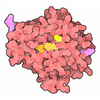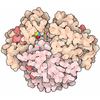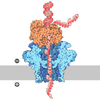+ データを開く
データを開く
- 基本情報
基本情報
| 登録情報 | データベース: PDB / ID: 6w0o | ||||||
|---|---|---|---|---|---|---|---|
| タイトル | Amyloid-beta(1-40) fibril derived from Alzheimer's disease cortical tissue | ||||||
 要素 要素 | Amyloid-beta precursor protein | ||||||
 キーワード キーワード | PROTEIN FIBRIL / amyloid-beta / Alzheimer's disease | ||||||
| 機能・相同性 |  機能・相同性情報 機能・相同性情報amyloid-beta complex / growth cone lamellipodium / cellular response to norepinephrine stimulus / growth cone filopodium / microglia development / collateral sprouting in absence of injury / Formyl peptide receptors bind formyl peptides and many other ligands / axo-dendritic transport / regulation of Wnt signaling pathway / regulation of synapse structure or activity ...amyloid-beta complex / growth cone lamellipodium / cellular response to norepinephrine stimulus / growth cone filopodium / microglia development / collateral sprouting in absence of injury / Formyl peptide receptors bind formyl peptides and many other ligands / axo-dendritic transport / regulation of Wnt signaling pathway / regulation of synapse structure or activity / axon midline choice point recognition / astrocyte activation involved in immune response / NMDA selective glutamate receptor signaling pathway / regulation of spontaneous synaptic transmission / mating behavior / growth factor receptor binding / peptidase activator activity / Golgi-associated vesicle / PTB domain binding / positive regulation of amyloid fibril formation / Insertion of tail-anchored proteins into the endoplasmic reticulum membrane / astrocyte projection / Lysosome Vesicle Biogenesis / neuron remodeling / Deregulated CDK5 triggers multiple neurodegenerative pathways in Alzheimer's disease models / nuclear envelope lumen / dendrite development / positive regulation of protein metabolic process / TRAF6 mediated NF-kB activation / signaling receptor activator activity / Advanced glycosylation endproduct receptor signaling / negative regulation of long-term synaptic potentiation / modulation of excitatory postsynaptic potential / The NLRP3 inflammasome / main axon / transition metal ion binding / regulation of multicellular organism growth / intracellular copper ion homeostasis / ECM proteoglycans / regulation of presynapse assembly / positive regulation of T cell migration / neuronal dense core vesicle / Purinergic signaling in leishmaniasis infection / positive regulation of chemokine production / cellular response to manganese ion / Notch signaling pathway / clathrin-coated pit / extracellular matrix organization / neuron projection maintenance / astrocyte activation / ionotropic glutamate receptor signaling pathway / Mitochondrial protein degradation / positive regulation of calcium-mediated signaling / positive regulation of mitotic cell cycle / axonogenesis / protein serine/threonine kinase binding / response to interleukin-1 / platelet alpha granule lumen / cellular response to copper ion / cellular response to cAMP / positive regulation of glycolytic process / central nervous system development / dendritic shaft / trans-Golgi network membrane / endosome lumen / positive regulation of interleukin-1 beta production / positive regulation of long-term synaptic potentiation / adult locomotory behavior / learning / positive regulation of JNK cascade / Post-translational protein phosphorylation / locomotory behavior / serine-type endopeptidase inhibitor activity / microglial cell activation / positive regulation of non-canonical NF-kappaB signal transduction / TAK1-dependent IKK and NF-kappa-B activation / cellular response to nerve growth factor stimulus / regulation of long-term neuronal synaptic plasticity / recycling endosome / synapse organization / visual learning / positive regulation of interleukin-6 production / response to lead ion / Golgi lumen / cognition / Regulation of Insulin-like Growth Factor (IGF) transport and uptake by Insulin-like Growth Factor Binding Proteins (IGFBPs) / endocytosis / cellular response to amyloid-beta / neuron projection development / positive regulation of inflammatory response / positive regulation of tumor necrosis factor production / Platelet degranulation / heparin binding / regulation of translation / regulation of gene expression / early endosome membrane / G alpha (i) signalling events / perikaryon / G alpha (q) signalling events / dendritic spine 類似検索 - 分子機能 | ||||||
| 生物種 |  Homo sapiens (ヒト) Homo sapiens (ヒト) | ||||||
| 手法 | 電子顕微鏡法 / 個体NMR / らせん対称体再構成法 / simulated annealing / クライオ電子顕微鏡法 / 解像度: 2.77 Å | ||||||
 データ登録者 データ登録者 | Ghosh, U. / Thurber, K.R. / Tycko, R. | ||||||
 引用 引用 |  ジャーナル: Proc Natl Acad Sci U S A / 年: 2021 ジャーナル: Proc Natl Acad Sci U S A / 年: 2021タイトル: Molecular structure of a prevalent amyloid-β fibril polymorph from Alzheimer's disease brain tissue. 著者: Ujjayini Ghosh / Kent R Thurber / Wai-Ming Yau / Robert Tycko /  要旨: Amyloid-β (Aβ) fibrils exhibit self-propagating, molecular-level polymorphisms that may contribute to variations in clinical and pathological characteristics of Alzheimer's disease (AD). We report ...Amyloid-β (Aβ) fibrils exhibit self-propagating, molecular-level polymorphisms that may contribute to variations in clinical and pathological characteristics of Alzheimer's disease (AD). We report the molecular structure of a specific fibril polymorph, formed by 40-residue Aβ peptides (Aβ40), that is derived from cortical tissue of an AD patient by seeded fibril growth. The structure is determined from cryogenic electron microscopy (cryoEM) images, supplemented by mass-per-length (MPL) measurements and solid-state NMR (ssNMR) data. Previous ssNMR studies with multiple AD patients had identified this polymorph as the most prevalent brain-derived Aβ40 fibril polymorph from typical AD patients. The structure, which has 2.8-Å resolution according to standard criteria, differs qualitatively from all previously described Aβ fibril structures, both in its molecular conformations and its organization of cross-β subunits. Unique features include twofold screw symmetry about the fibril growth axis, despite an MPL value that indicates three Aβ40 molecules per 4.8-Å β-sheet spacing, a four-layered architecture, and fully extended conformations for molecules in the central two cross-β layers. The cryoEM density, ssNMR data, and MPL data are consistent with β-hairpin conformations for molecules in the outer cross-β layers. Knowledge of this brain-derived fibril structure may contribute to the development of structure-specific amyloid imaging agents and aggregation inhibitors with greater diagnostic and therapeutic utility. | ||||||
| 履歴 |
|
- 構造の表示
構造の表示
| ムービー |
 ムービービューア ムービービューア |
|---|---|
| 構造ビューア | 分子:  Molmil Molmil Jmol/JSmol Jmol/JSmol |
- ダウンロードとリンク
ダウンロードとリンク
- ダウンロード
ダウンロード
| PDBx/mmCIF形式 |  6w0o.cif.gz 6w0o.cif.gz | 549.1 KB | 表示 |  PDBx/mmCIF形式 PDBx/mmCIF形式 |
|---|---|---|---|---|
| PDB形式 |  pdb6w0o.ent.gz pdb6w0o.ent.gz | 462.2 KB | 表示 |  PDB形式 PDB形式 |
| PDBx/mmJSON形式 |  6w0o.json.gz 6w0o.json.gz | ツリー表示 |  PDBx/mmJSON形式 PDBx/mmJSON形式 | |
| その他 |  その他のダウンロード その他のダウンロード |
-検証レポート
| 文書・要旨 |  6w0o_validation.pdf.gz 6w0o_validation.pdf.gz | 418.2 KB | 表示 |  wwPDB検証レポート wwPDB検証レポート |
|---|---|---|---|---|
| 文書・詳細版 |  6w0o_full_validation.pdf.gz 6w0o_full_validation.pdf.gz | 609.3 KB | 表示 | |
| XML形式データ |  6w0o_validation.xml.gz 6w0o_validation.xml.gz | 26.5 KB | 表示 | |
| CIF形式データ |  6w0o_validation.cif.gz 6w0o_validation.cif.gz | 42 KB | 表示 | |
| アーカイブディレクトリ |  https://data.pdbj.org/pub/pdb/validation_reports/w0/6w0o https://data.pdbj.org/pub/pdb/validation_reports/w0/6w0o ftp://data.pdbj.org/pub/pdb/validation_reports/w0/6w0o ftp://data.pdbj.org/pub/pdb/validation_reports/w0/6w0o | HTTPS FTP |
-関連構造データ
| 関連構造データ |  21501MC M: このデータのモデリングに利用したマップデータ C: 同じ文献を引用 ( |
|---|---|
| 類似構造データ | |
| その他のデータベース |
|
- リンク
リンク
- 集合体
集合体
| 登録構造単位 | 
| |||||||||
|---|---|---|---|---|---|---|---|---|---|---|
| 1 |
| |||||||||
| NMR アンサンブル |
| |||||||||
| 対称性 | らせん対称: (回転対称性: 1 / Dyad axis: no / N subunits divisor: 1 / Num. of operations: 6 / Rise per n subunits: 2.45 Å / Rotation per n subunits: 179.66 °) |
- 要素
要素
| #1: タンパク質・ペプチド | 分子量: 4335.852 Da / 分子数: 6 / 断片: UNP residues 653-692 / 由来タイプ: 合成 / 由来: (合成)  Homo sapiens (ヒト) / 参照: UniProt: P05067 Homo sapiens (ヒト) / 参照: UniProt: P05067 |
|---|
-実験情報
-実験
| 実験 |
| ||||||||||||||||||||||||||||||||||||
|---|---|---|---|---|---|---|---|---|---|---|---|---|---|---|---|---|---|---|---|---|---|---|---|---|---|---|---|---|---|---|---|---|---|---|---|---|---|
| EM実験 | 試料の集合状態: FILAMENT / 3次元再構成法: らせん対称体再構成法 | ||||||||||||||||||||||||||||||||||||
| NMR実験 |
|
- 試料調製
試料調製
| 構成要素 | 名称: amyloid-beta(1-40) fibrils derived from human AD brain タイプ: COMPLEX 詳細: Fibrils produced by seeded growth using amyloid-beta in brain extract as the source of seeds. CryoEM and solid state NMR measurements were performed on second-generation seeded fibrils. Entity ID: all / 由来: NATURAL |
|---|---|
| 分子量 | 値: 29 kDa/nm / 実験値: YES |
| 由来(天然) | 生物種:  Homo sapiens (ヒト) Homo sapiens (ヒト) |
| 緩衝液 | pH: 7.4 詳細: 10 mM phosphate buffer with 0.01% NaN3 to avoid microbial contamination. Buffers were filtered to avoid contamination. |
| 緩衝液成分 | 濃度: 10 mM / 名称: Phosphate buffer / 式: Na2HPO4/NaH2PO4 |
| 試料 | 濃度: 0.45 mg/ml / 包埋: NO / シャドウイング: NO / 染色: NO / 凍結: YES 詳細: Protein exists in solution as amyloid fibrils of varying lengths. |
| 試料支持 | 詳細: The grids were checked in microscope prior to use. / グリッドの材料: GOLD / グリッドのサイズ: 300 divisions/in. / グリッドのタイプ: Quantifoil R1.2/1.3 |
| 急速凍結 | 装置: LEICA PLUNGER / 凍結剤: ETHANE / 湿度: 90 % / 凍結前の試料温度: 293 K 詳細: The grids were preblotted for 10 seconds and blotted for 6 seconds before plunging. |
| 詳細 | タイプ: fibrous protein 内容: 100 uM U-15N,13C amyloid-beta(1-40), phosphate buffer 詳細: lyophilized, rehydrated in MAS rotor, 100 uM concentration prior to pelleting Label: U-labeled fibrils / 溶媒系: phosphate buffer |
| 試料 | 濃度: 100 uM / 構成要素: amyloid-beta(1-40) / Isotopic labeling: U-15N,13C |
| 試料状態 | 詳細: pelleted, lyophilized, rehydrated in MAS rotor / イオン強度: 10 mM / Label: conditions_1 / pH: 7.4 / PH err: 0.05 / 圧: 1 atm / 温度: 297 K / Temperature err: 2 |
-データ収集
| 実験機器 |  モデル: Titan Krios / 画像提供: FEI Company |
|---|---|
| 顕微鏡 | モデル: TFS KRIOS 詳細: Preliminary grid screening was done manually in FEI T12. |
| 電子銃 | 電子線源:  FIELD EMISSION GUN / 加速電圧: 300 kV / 照射モード: FLOOD BEAM FIELD EMISSION GUN / 加速電圧: 300 kV / 照射モード: FLOOD BEAM |
| 電子レンズ | モード: BRIGHT FIELD / 倍率(公称値): 130000 X / 最大 デフォーカス(公称値): -3000 nm / 最小 デフォーカス(公称値): -500 nm / Cs: 2.7 mm / C2レンズ絞り径: 100 µm / アライメント法: COMA FREE |
| 試料ホルダ | 凍結剤: NITROGEN 試料ホルダーモデル: FEI TITAN KRIOS AUTOGRID HOLDER Residual tilt: 6 mradians |
| 撮影 | 平均露光時間: 10 sec. / 電子線照射量: 73.5 e/Å2 / 検出モード: SUPER-RESOLUTION フィルム・検出器のモデル: GATAN K2 QUANTUM (4k x 4k) 撮影したグリッド数: 1 / 実像数: 1337 |
| 電子光学装置 | エネルギーフィルター名称: GIF Quantum LS / エネルギーフィルタースリット幅: 20 eV |
| 画像スキャン | 動画フレーム数/画像: 50 / 利用したフレーム数/画像: 1-50 |
| NMRスペクトロメーター | タイプ: Varian InfinityPlus / 製造業者: Varian / モデル: InfinityPlus / 磁場強度: 600 MHz |
- 解析
解析
| EMソフトウェア |
| ||||||||||||||||||||||||||||||||||||||||||||||||||
|---|---|---|---|---|---|---|---|---|---|---|---|---|---|---|---|---|---|---|---|---|---|---|---|---|---|---|---|---|---|---|---|---|---|---|---|---|---|---|---|---|---|---|---|---|---|---|---|---|---|---|---|
| 画像処理 | 詳細: The selected images were corrected for gain. The gain reference was not rotated or flipped. | ||||||||||||||||||||||||||||||||||||||||||||||||||
| CTF補正 | 詳細: The correction was done in Gctf and is corrected for amplitude. Per -particle CTF refinement was done prior to final reconstruction. タイプ: PHASE FLIPPING AND AMPLITUDE CORRECTION | ||||||||||||||||||||||||||||||||||||||||||||||||||
| らせん対称 | 回転角度/サブユニット: 179.66 ° / 軸方向距離/サブユニット: 2.45 Å / らせん対称軸の対称性: C1 | ||||||||||||||||||||||||||||||||||||||||||||||||||
| 粒子像の選択 | 選択した粒子像数: 19790 詳細: The particles were picked using Relion manual pick, with a 20A low pass filter and particle diameter of 30A. | ||||||||||||||||||||||||||||||||||||||||||||||||||
| 3次元再構成 | 解像度: 2.77 Å / 解像度の算出法: FSC 0.143 CUT-OFF / 粒子像の数: 14775 / アルゴリズム: FOURIER SPACE 詳細: A modified version of RELION 3.0-beta was used for the reconstruction. The modified version allowed local averaging of the rotation angle. Final reconstruction used 2-fold screw symmetry. クラス平均像の数: 1 / 対称性のタイプ: HELICAL | ||||||||||||||||||||||||||||||||||||||||||||||||||
| 原子モデル構築 | プロトコル: AB INITIO MODEL / 空間: REAL 詳細: Xplor-NIH was used to combine EM density with phi/psi restraints from NMR chemical shifts (from Talos-N Version 4.21 Rev 2016.343.11.31). | ||||||||||||||||||||||||||||||||||||||||||||||||||
| NMR software |
| ||||||||||||||||||||||||||||||||||||||||||||||||||
| 精密化 | 手法: simulated annealing / ソフトェア番号: 3 / 詳細: phi/psi from TalosN & EM density used as restraints | ||||||||||||||||||||||||||||||||||||||||||||||||||
| 代表構造 | 選択基準: lowest energy | ||||||||||||||||||||||||||||||||||||||||||||||||||
| NMRアンサンブル | コンフォーマー選択の基準: structures with the least restraint violations 計算したコンフォーマーの数: 60 / 登録したコンフォーマーの数: 10 |
 ムービー
ムービー コントローラー
コントローラー



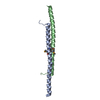
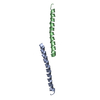
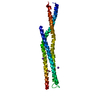
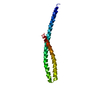
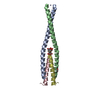
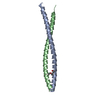
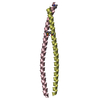

 PDBj
PDBj








